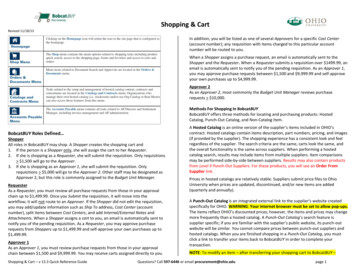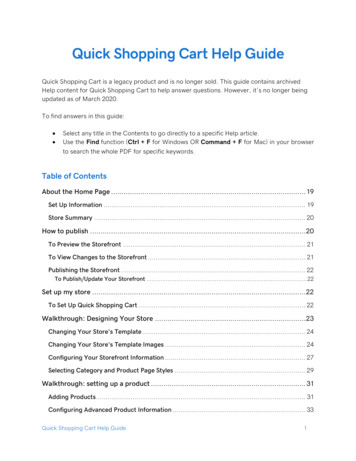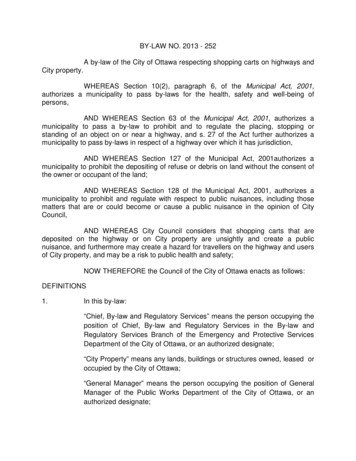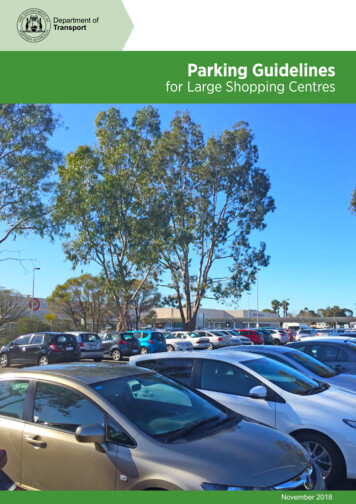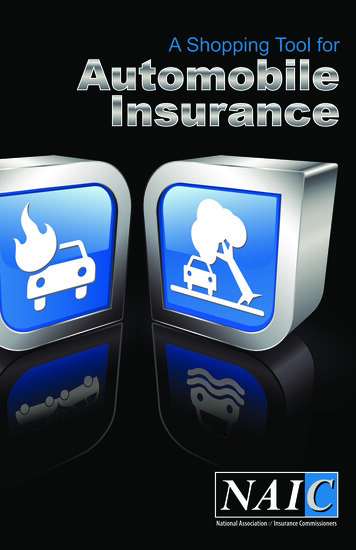
Transcription
A Shopping Tool forAutomobileInsuranceMississippiInsurance Department1
A Shopping Tool for 2014 National Association of Insurance CommissionersAll rights reserved.National Association of Insurance CommissionersInsurance Products & Services naic.orgPrinted in the United States of AmericaYou may reprint this consumer guide in hard copy, on a website, or via otherelectronic communication. The consumer guide must be reproduced in full andcontain the copyright of the National Association of Insurance Commissioners.NAIC Executive OfficeHall of States Bldg.444 North Capitol NW, Suite 701Washington, DC 20001-1509202-624-7790NAIC Central Office1100 Walnut Street, Suite 1500Kansas City, MO 64106-2197816-842-3600NAIC Capital Markets and Investment Analysis OfficeOne New York Plaza, Suite 4210New York, NY 100042
About the NAIC The National Association of Insurance Commissioners (NAIC) is the oldestassociation of state government officials. Its members consist of the chiefinsurance regulators in all 50 states, the District of Columbia and five U.S.territories. The primary responsibility of the state regulators is to protect theinterests of insurance consumers, and the NAIC helps regulators fulfill thatobligation in a number of different ways. This guide is one example of work doneby the NAIC to assist states in educating and protecting consumers.Another way the NAIC lends support to state regulators is by providing a forumfor the development of uniform public policy when uniformity is appropriate. Itdoes this through a series of model laws, regulations and guidelines, developedfor the states’ use. States that choose to do so may adopt the models intact ormodify them to meet the needs of their marketplace and consumers.The NAIC’s mission is to assist state insurance regulators, individually andcollectively, in serving the public interest and achieving the following fundamentalinsurance regulatory goals in a responsive, efficient and cost effective manner,consistent with the wishes of its members: Protect the public interest. Promote competitive markets. Facilitate the fair and equitable treatment of insurance consumers. Promote the reliability, solvency and financial solidity of insurance institutions. Support and improve state regulation of insurance.1
A Shopping Tool forNeed Auto Insurance?Here is What You Need to Know.Whether you are buying auto insurance for the first time, or shopping to be sureyou are getting the best deal, you already know how important auto insurance is.By law in most states, if you own a car, you must have some auto insurance.Remember, there is no such thing as a “full coverage” auto insurance policy.Policies are made up of different types of coverages. Your state’s laws or yourauto lender may require you to have some coverages, but you may want to buyothers, if you can afford it.Your family and friends can be great resources to find an agent or insurancecompany. You also can look online or in your local phonebook. Some insurers donot use agents and deal with customers directly online or via toll-free numbers.Some agents represent more than one insurance company. Contact more thanone agent or insurance company to be sure you get at least three quotes whenyou shop for insurance.The information in this guide will help you become an informed shopper. It willhelp you understand the coverages you can buy. The suggested questions to askan agent or insurance company will help you be sure you get the coverages youwant. It also will help you understand the types of information you will need to geta premium estimate or quote.This guide helps answer the following questions: What policy should I buy? What are the different types of auto coverages? How much liability coverage should I buy? What information will I be asked for? What questions should I ask? How do insurers determine auto premiums? What should I look for when I comparison shop? What is a declarations page? What should I know if I am changing insurance companies? What is the difference between cancellation and non-renewal? What if I cannot find auto insurance? Where can I get more information?Remember, the information in this guide is intended to help you understandauto insurance. The information is general and not specific to your state or yourinsurance policy. If you have specific questions about your coverage, call youragent or insurance company.2
What Policy Should I Buy?Everyone has different needs. But when you buy auto insurance, everyoneshould look for a policy that does the following:1) Provides at least the minimum coverage that your state’s law requires.You do not want to be fined or lose your license because you didnot follow the law. The minimum coverage amounts are different ineach state. Check with your state Department of Motor Vehicles orDepartment of Insurance to learn what your state requires.2) Provides enough liability coverage to pay someone else for theirproperty damage, medical care and other costs that you may cause.Accidents happen, even to the best drivers. You should buy as muchliability coverage as you can reasonably afford to protect yourselffinancially. See the “What are the different types of auto coverages?”section for more information.3) Provides you with enough coverage to pay for your own propertydamage, medical care and other costs if there is an accident. If you arein an accident, you probably will need insurance to be able to repairyour car and pay for your medical care.4) Provides you with coverage you may be required to buy if you havean auto loan or lease. Most often, you must have comprehensive(sometimes called “other than collision”) and collision coverages untilyou pay off your loan. See the “What are the different types of autocoverages?” section for more information.5) Provides coverage for all members of your household, includingstudents away at school or other adults who live with you. You mayhave teenagers in your household or others living with you who havebad driving records. Including them on your policy will increase yourinsurance costs. While it may seem easy to leave them off your autopolicy to save money, you may be responsible for any damages orinjuries they cause. It is best to insure everyone living with you who hasa driver’s license, not just your immediate family.3
A Shopping Tool forWhat Are the Different Types of Auto Coverages?You may be shopping for insurance in person, over the phone or via the Internet.Regardless of how you are shopping, one of the first questions you will be asked iswhich coverages you want. Remember, there is no such thing as “full coverage.”Following are the common auto insurance coverages and a brief description ofwhat each does. Not all of these coverages will be available in your state. Eachcoverage you buy is priced separately. Ask your insurance agent or insurer formore information.Liability CoveragesMost states require you to buy a minimum amount of liability coverage to payfor damages or injuries you cause to others. The amount varies by state. Youwill be responsible for any property damage or bodily injury you cause abovethis amount, so think carefully before buying only the minimum. See “HowMuch Liability Coverage Should I Buy?” for more information.Bodily injury liability insurance. This coverage applies to injuries that youcause to someone else. You (and anyone else listed on your policy) are coveredfor your liability for damage and injuries caused in an accident, up to your policylimits.Property damage liability insurance. This coverage pays for damagesyou cause to someone else’s car or to objects and structures your car hits.Note: In some states your policy could cover others not listed on your policy,up to your policy limit, if they drive your car with your permission.Medical Payments/Personal Injury Protection (PIP)In some states, you must have a minimum amount of coverage to pay foryour medical expenses and lost wages, regardless of who is responsiblefor the car accident.Medical Payments Insurance. This coverage pays to treat injuries to youand your passengers.Personal Injury Protection (PIP). This coverage, if available or requiredin your state, pays to treat injuries to you and your passengers, but also cancover such things as lost wages and funeral costs.Excess Medical Payments. This coverage pays for necessary medicalcosts greater than those paid under PIP/ benefits.4
Uninsured and Underinsured Motorist CoveragesBy law in most states, you must have a minimum amount of both typesof coverage. The amount varies by state.Uninsured Motorist Bodily Injury (UM or UMBI). This coverage paysfor your bodily injuries and those of your passengers if you are hit by a hit-andrun driver or an uninsured driver who is at fault.Uninsured Motorist Property Damage. This coverage pays for damage toyour car if you are hit by a hit and-run-driver or an uninsured driver who is at fault.Underinsured Motorist Coverage. This coverage pays for your bodilyinjuries and those of your passengers if you are hit by an underinsured driverwho is at fault. “Underinsured” will be defined by your state law or by yourinsurance policy. That means this coverage can vary by state or by insurancepolicy.Property (Physical) Damage CoveragesState laws do not require you to buy physical damage coverages foryour car, but your lender may, at least until you pay off your loan.Collision. This coverage pays to repair your car. Or if the insurer decidesyour car is “totaled,” it pays you your car’s actual cash value. This coverageusually has a deductible, which is the amount of the claim that is yourresponsibility.Comprehensive (sometimes called “Other than Collision”). Thiscoverage pays for damage to your car that is NOT from a collision. Thisusually includes damage caused by fire, theft, vandalism, falling objects, hail,flood or an accident involving a bird or animal. This coverage usually has adeductible, which is the amount of the claim that is your responsibility.A Note about DeductiblesIf you file a claim with your insurance company for damage to yourvehicle, you will have to pay the amount of the deductible to repair yourautomobile. Keep in mind that you will have to pay this deductible anytime you file a claim with your insurance company – even if you are notat fault for the damage.5
A Shopping Tool forOther Optional CoveragesYou also may be able to choose other optional coverages. Some of thecommon optional coverages are described below. Ask your insurancecompany or agent about what coverages you may want or need.Rental reimbursement pays a limited amount for daily rental car chargeswhile your car is being repaired for covered damages. Policies usually limitthe dollar amount and the number of days covered. In some states rentalcar coverage would fall under your comprehensive and collision coverage;however, there are variations in how this coverage applies. If you want toknow what your auto policy will cover when you rent a car, ask your agent.Towing coverage (also could be called Roadside Assistance)reimburses you for your costs if your car is disabled. For example, thecoverage might pay if you have your car towed to a service facility or you lockyour keys in the car.Guaranteed Asset Protection (GAP) insurance (sometimes called loan/lease coverage or debt cancellation) may help pay off what you owe if youowe more on your car than it is worth. It would provide protection whether theaccident is your fault or someone else’s. This protection can be purchasedfrom a lender, your car dealer or an insurance company or agent. Contact oneof these entities if you want to know more about this coverage.6
What Do My Liability Limits Mean andHow Much Should I Buy?Liability insurance coverage usually is described in three numbers: 25/50/15, forinstance. These numbers refer to limits for the different types of liability coverage.These coverage limits are the most your insurance policy will pay for injuries toany one person, all persons injured in an accident and for property damage.The first number in the example means 25,000 is the most this policy would payfor bodily injury per person. The second number means 50,000 is the most thispolicy would pay for bodily injury per accident, regardless of how many peopleare injured. The third number means 15,000 is the most this policy would payfor any property damage you cause in one accident, regardless of the number ofcars or other properties damaged.You should consider buying more coverage than the law requires becauseaccidents happen every day – even to good drivers. If you do not have enoughliability coverage, and you are found at fault for an accident, you would beresponsible to pay for anything your insurance does not cover. Medical costsand legal costs are very high and increasing every day. If you could not afford topay these costs out of pocket, then you should buy more than just the minimumliability coverage limits your state law requires. You should purchase the mostcoverage you can reasonably afford to protect your financial security.7
A Shopping Tool forWhat Information Will I Be Asked For?When you shop for auto insurance, you will be asked to give a lot of informationabout yourself, other household residents including students away at school, yourcar and how you use your car. Below are some questions you may be asked. Ifyou do not have all of the information, pull together what you can and an agent orinsurance company representative may be able to help you with the rest.Questions about the people the insurance policy coversPrincipal Driver Address, Social Security Number, age or years of driving experience, sex,marital status Driver’s license numberOther Drivers in Household (may include future drivers) Social Security Number, age or years of driving experience, sex, marital status Driver’s license number Number of accidents in the last three years for the principal driver Number of accidents in the last three years for other drivers living in yourhousehold Number of traffic convictions for moving violations for the principal driver Number of traffic convictions for moving violations for other drivers living inyour household Principal driver’s previous auto insurer and policy number Insurance information for other drivers in your household who will not becovered under your policyQuestions about the car the insurance policy will coverType of car(s) to be insured Make (e.g., Ford or Chevrolet) Model (e.g., Taurus or F-150) Year VIN Number (you often can find this on your title or registration) Odometer reading Name of lender and/or owner of the carQuestions about how the car is used Do you use the car for pleasure only (for example, a convertible you driveon the weekend)? Do you use the car to commute to and from work or school? Do you use your car for business purposes (for example, sales ortransporting goods for hire)? What is your average annual mileage? How many miles do you drive to work or school? Where do you live? Is that where the car is?8
What Questions Should I Ask?The insurer will ask you questions and use the answers to decide whetherto insure you and how much your premium should be. You also should askquestions to be sure you are getting the coverage you want and from an agentand insurer you trust.Here are some questions you should ask your agent or company representativewhen you shop for auto insurance: What coverages am I required to have in this state? What is the minimum amount of liability insurance coverage this staterequires me to carry? Are these liability limits high enough to cover me if I have an accident and Iam at fault? How much would it cost me to buy more than the minimum amount ofliability insurance coverage? Do I need collision and comprehensive (sometimes called “other thancollision”) coverage? What deductible should I have for collision coverage? For comprehensive(sometimes called “other than collision”) coverage? Will this policy cover me if I let someone else drive my car? Will this policy cover me if I have an accident in a rental car while onvacation? Will this policy cover me if I have an accident while traveling for work? If my car is totaled, how is the value of my vehicle set? Can I choose any body shop or glass shop to repair my car? Does thepolicy pay for original manufacturer’s parts or aftermarket parts? If my car is disabled, will this policy pay for a rental car while it is beingrepaired? Is there any cap or limit? If my car is disabled, will this policy pay to have it towed to a garage orbody shop? How much can I save with a higher deductible? What discounts are available? What other types of property do you insure? Can I qualify for a discount if Ibuy both policies from your company? What are my payment options? Can I pay monthly or quarterly? If I do, isthere an extra charge? How do I report a claim – do you have 24 hour claims service?9
A Shopping Tool forHow Do Insurers Determine Auto Premiums?The insurer uses each piece of information it gets from and about you to decidewhether to insure you and how much you will pay for auto insurance. That isbecause each is linked to a factor that affects your premium. Some factors arerelated to the characteristics of the driver(s) and some to the type of car insured.Others are based on the amount of coverage you buy. There also are discountsthat will reduce the premium.Not every insurer uses the same factors. Which factors insurers use to determinepremium is different in each state. Below are examples of some of the mostcommon rating factors that insurers use.Driver CharacteristicsGeneral Information about the DriverAge, years of driving experience, gender and marital status are common factorsused to calculate premiums. The insurer will obtain information about your drivingrecord and accident history from a third-party company. Generally, younger, lessexperienced drivers pay more than older, experienced drivers; females pay lessthan similar age males; and married people pay less than single people.Driving Safety RecordYou will pay more if you or other drivers insured by your policy have beenconvicted of speeding or other traffic violations or were responsible for accidents.Insurers get information about traffic convictions from the state Department ofMotor Vehicles and from third-party vendors, such as CLUE, that collect data oninsurance claims.Principal OperatorWhen there is more than one driver or car in a household, insurers have rulesto decide which driver determines the premium for each car. Some insurerscalculate the premium based on the driver who uses a car the most. Otherinsurers may use the highest-risk driver, usually the youngest driver in thehousehold, as the “principal operator” to determine the premium for a car, even ifthat young driver uses the car very little.Annual Mileage and Vehicle UseGenerally, the more miles you drive each year, the more you will pay forinsurance. You will also pay a higher premium if you use your car for business.Location/Garaging Address of the Insured VehicleYour premium will be higher or lower based on the insurer’s claims experience inthe ZIP code or territory where you live. For example, urban areas tend to havehigher rates than suburban or rural areas.10
EducationIf state law allows, insurers may use the highest level of education achieved asa rating factor. In this rating factor, for example, those with a college degree payless.Insurance Credit ScoreIf state law allows, insurers may use an insurance credit score as a rating factor.An insurance credit score is a number based on various financial, credit andrisk factors. Some companies offer discounts to consumers who have higherinsurance credit scores.“Usage-Based” Rating FactorsSome insurers use data from an electronic device in your car as a factor todetermine your premiums. The device collects information about when and howyou drive the car. Rates are lower if you drive fewer miles, drive during lessdangerous hours of the day and seldom brake hard or swerve. Insurers usuallygive drivers a small discount just for agreeing to participate in the program. Theagent or company representative can give you more information about theseprograms.Type of CarCost to Repair or ReplaceRates are higher for cars that cost more to repair or replace. Expect higher ratesfor higher value cars, new cars and cars that often are stolen.Special FeaturesRates are higher for cars with special features such as all-wheel drivetransmissions and hybrid engines, or for sports cars. Insurers charge less forcars with features such as an alarm system. They also charge less for carswith better passenger protection, such as those with comprehensive restraintsystems.Amount of CoverageLimits of Liability/Medical Payments/Uninsured Motorist/Underinsured MotoristRates are higher for higher limits on these coverages.DeductiblesRates are higher for policies with lower deductibles. Consider increasing yourdeductible to lower your premium.Rental ReimbursementRates are higher for more generous benefits – a larger dollar amount or moredays of coverage.11
A Shopping Tool forDiscountsGeneral DiscountsRates are lower if you have more than one policy with the same insurer. Ratesalso are lower if you keep a car insured than if you have never had coverage orhave a gap in coverage. Some companies offer discounts to good students andthose with defensive driving training.Group MembershipsRates may be lower if you qualify for a discount as a member of an organizationsuch as an alumni association, a union or another club or a purchasing group.SummaryThe premium you are quoted is based on your answers to the questions thatyou are asked. Premiums for auto insurance are tailored to each individual andeach insurer uses different rating factors. So, it is likely your premium will be verydifferent at each insurer. That is why it is so important to shop around!What Should I Look for When I Comparison Shop?Use the chart on the following page to take notes as you are shopping forauto insurance. It is important to compare the same or similar coveragewhen you shop.12
Company 1 Company 2 Company 3 Company 4Liability CoveragesNote the limits of coverage below for each company’s quote to be sure you are comparing the same coverage.Bodily Injury LiabilityProperty Damage LiabilityUninsured/Underinsured Motorist CoveragesNote the limits of coverage below for each company’s quote to be sure you are comparing the same coverage.Uninsured Motorist Bodily InjuryUninsured Motorist Property DamageUnderinsured Motorist CoverageCoverages for MedicalNote the limits of coverage below for each company’s quote to be sure you are comparing the same coverage.Medical PaymentsPersonal Injury ProtectionExcess Medical PaymentsPhysical Damage CoveragesNote the deductible below for each company’s quote to be sure you are comparing the same coverage.Collision – Deductible AmountComprehensive(Other than Collision) –Deductible AmountOther Optional CoveragesNote the cost below for each type of coverage. Not all coverages below have a coverage limit.Rental ReimbursementTowingGAP CoverageQuotesTotal annual premiumSix-month premiumMonthly premium13
A Shopping Tool forWhat Is a Declarations Page?A declarations page gives you details about your insurance coverage. Once youreceive your insurance policy, the first thing you should read is the declarationspage so you can make sure you have the coverage you wanted to buy. Usethis example to help you read your declarations page to better understand yourcoverage.14
What to Do if You Cannot Find InsuranceIf you cannot find insurance because of your driving record, you are a new driver,or do not have prior insurance, contact your state insurance department. Ask ifyour state has an insurance program for high-risk drivers who are unable to getcoverage. The insurance premiums for high-risk drivers will be higher than thepremiums for other drivers.For More InformationThere is much more information available about auto insurance. If you still havequestions or want more information about auto or other types of insurance, you can: Talk with your insurance agent or insurer representative. They will help younavigate the insurance shopping process and the insurer’s process to makea claim. If you have questions or problems with your insurance coverage,call your agent or insurance company. Visit insurance companies’ websites. Many companies’ websites haveinformation about auto insurance coverage. Contact your state department of insurance. Most departments have tollfree numbers you can call to talk with insurance department staff who cananswer general questions and give you more information. Look in your localphone book for the department of insurance. Visit your state department of insurance website. Most state insurancedepartment websites have consumer information. Some state insurancedepartments post information on consumer complaints filed againstinsurance companies and agents. To find the website of your statedepartment, visit the National Association of Insurance Commissioners(NAIC) website at www.naic.org/state web map.htm and select your stateon the map.The National Association of Insurance Commissioners (NAIC) also has a numberof online resources available for consumers on auto insurance as well as othertypes of insurance. You can find the NAIC’s Consumer Resources Web page at:www.naic.org/consumer home.htm.15
A Shopping Tool forIn addition to consumer news and alerts about insurance, the NAIC’s ConsumerResources include: A Consumer’s Guide to Auto Insurance. A comprehensive consumerguide on auto insurance, which provides a more detailed review of autoinsurance coverage, why you need it, how it works, how your premiums aredetermined and your responsibilities as a r guide auto.pdf The Consumer Information Source. Do you want to know more about theinsurance companies you are comparing? This website gives you access toinformation about insurance companies, including information on consumercomplaints against insurance companies: https://eapps.naic.org/cis/Other Consumer Resources and Information For your free annual credit report, go to www.annualcreditreport.com orcall 877.322.8228. Check your credit report and dispute any errors with thecredit bureau before you apply for insurance. For your free annual (Comprehensive Loss Underwriting Exchange)C.L.U.E. report CLUE report, go to www.choicetrust.com or call866.312.8076. A C.L.U.E. report includes policy information, such as name,date of birth, policy number, claim information such as date of loss, type ofloss and amounts paid, and a description of the automobile covered. Checkyour CLUE report and dispute any errors before you apply for insurance.16
17
A Shopping Tool for18
Whether you are buying auto insurance for the first time, or shopping to be sure you are getting the best deal, you already know how important auto insurance is. By law in most states, if you own a car, you must have some auto insurance. Remember, there is no such thing as a "full coverage" auto insurance policy.

